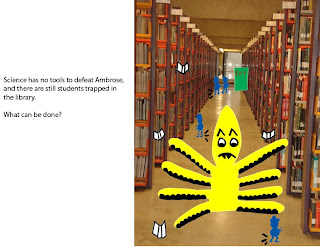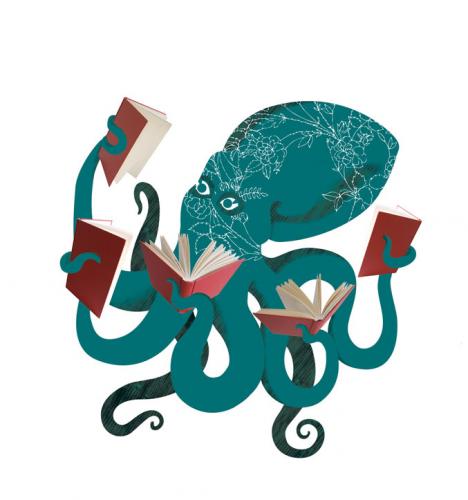1.
(Done in Star Wars flying text)
In a land were history has turned into mythology.
Where people copy and steal from others.
Where the historian has been caste from the Ivy towers,
And thrown into the dingy pits of the mines,
Forced to perform manual labour for eternity.
Their books locked-up, and their primary documents destroyed.
There is no hope left for the scholarly world…..
2.
The Adventures of…..
Ninja Historian
(KA POW! N.H. does flying kick through screen)
3.
On the highest floor, of the largest library chaos has taken over.
The 10-foot tall, man eating, octopus – Ambrose, has just devoured the knowledge from half the monographs on the fifth floor of Weldon Library.
The Engineers, whose section Ambrose has just destroyed, are fleeing after a failed attempt to subdue the octopus.
Science has no tools to defeat Ambrose, and there are still students trapped in the library.
What can be done?
4.
Ninja Historian approaches as stealthily as a Grey Wolf, Ambrose does not hear a noise.
Ambrose lunges for a student, but he is too slow.
N.H. strikes Ambrose with a hard karate-chop
5.
Angered, Ambrose uses the ink that he has stolen from the books, to whip it at N.H.
With the ease and grace of a dancer, N.H. leaps away from the ink, never being hit.
6.
Next Ambrose uses his 10-foot long tentacles to swing at N.H.
After leaping away from one, N.H. is hit from behind by another tentacle.
(N.H. is knocked through the air.)
Worry creeps over N.H.
Can he really defeat such a large plagiarizing beast, the more knowledge he steels the more powerful Ambrose gets.
7.
N.H. takes out his throwing stars (that are FN for Foot note) and whips them at Ambrose.
One, after another, and F.N. cuts off the eight arms of the octopus.
Ambrose is scared. The F.N.s will not come off.
8.
Close up of a F.N. leaching on to the severed tentacle, slowly expanding around the tentacle.
9.
Full views of Ambrose watching in amazement, as his severed tentacles begin to shrink.
10.
Ambrose continues to shrink into human size.
11.
A tiny first year appears where Ambrose the octopus once stood. Shacking with fear.
12.
N.H. pulls out his Rampola Style guide, and tosses it at the boy.
13.
The boy catches the Rampola Style guide.
The N.H.’s voice is heard saying: “Source it!”
Character Background:
10-foot tall octopus. Name: Ambrose
Why is Ambrose Evil? – He sucks out all the information from the books and does not reference where he got his knowledge. When he takes the information, the pages of the books are left blank, stealing knowledge from the world. Further, he uses the ink from the books as a weapon against Ninja Historian. The ink is hot, it can burn.
Named After: Ambrose is named after popular historian Stephen Ambrose. He wrote Band of Brothers, which became a popular mini-series on HBO. However, he is a known plagiarizer. In his book The Wild Blue, he copied full passages from Thomas Childers’ book Wings of Morning.
Ninja Historian- One bad-ass historian. (that’s all that needs to be said)
I think it’s essential that my characters have a deep history, and that future plots include illusions to famous books, to make the text richer. I personally love figuring out what authors are referencing and looking deeper into it. I think it’s a great way of learning lots of little things.
































